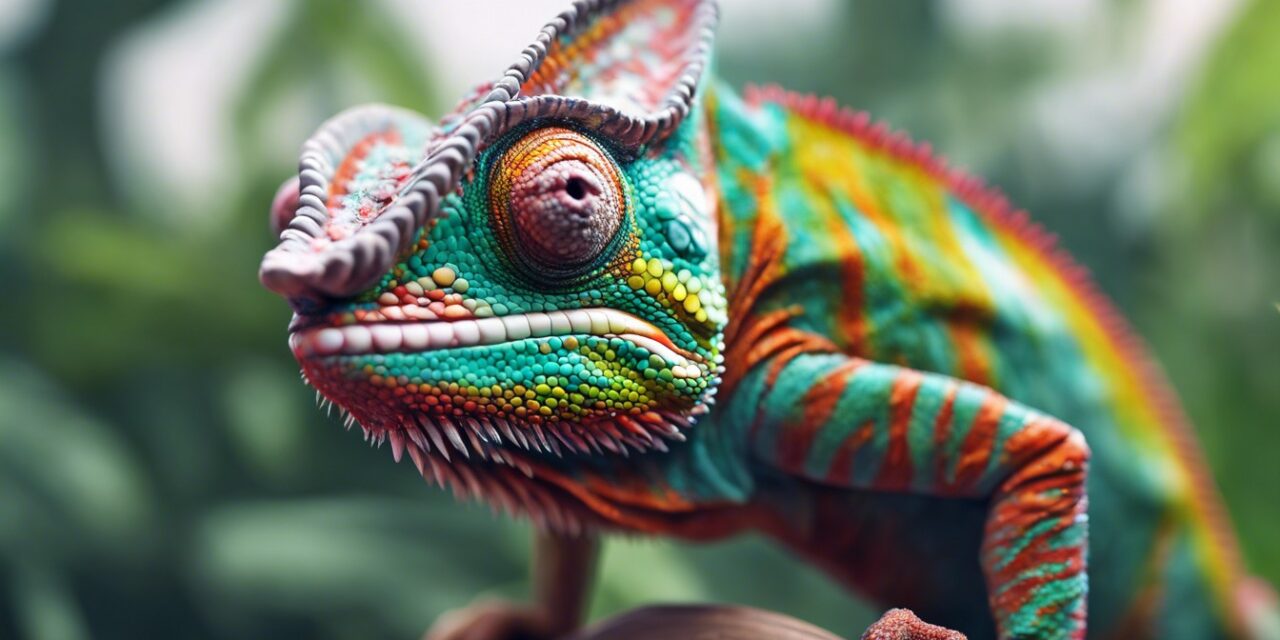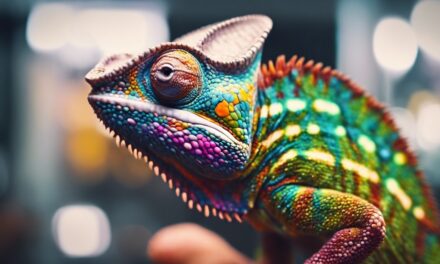Owning a Chameleon as a Pet
Considering owning a chameleon as a pet? Chameleons are fascinating creatures that captivate the hearts of reptile enthusiasts and pet lovers alike. However, before bringing one into your home, it’s essential to understand the characteristics of chameleons as pets.
Chameleons possess unique qualities that make them both intriguing and challenging to care for. Their ability to change colors is one of their most remarkable features, allowing them to blend into their surroundings or communicate with other chameleons. This captivating trait often draws people towards owning a chameleon.
When it comes to caring for chameleons, there are specific requirements that need to be met. These include providing an appropriate habitat, ensuring proper nutrition, and understanding their social behavior. Creating the ideal environment for your chameleon is crucial for its overall well-being.
Chameleons require specialized care due to their specific needs. They thrive in environments with controlled temperature, lighting, and humidity levels. Additionally, their diet consists primarily of insects and plant matter, which must be carefully balanced to meet their nutritional needs.
While owning a chameleon can be rewarding, it’s important to consider the challenges associated with chameleon ownership. Chameleons require dedicated time and effort for their care and maintenance. They may not be suitable pets for those seeking low-maintenance companionship.
Understanding Chameleon Characteristics
Chameleons possess a range of unique physical and behavioral traits that set them apart from other reptiles. By understanding these characteristics, you can gain insight into their fascinating nature.
Physical and Behavioral Traits
Chameleons are known for their distinctive physical features. Their most recognizable trait is their ability to change colors. This remarkable adaptation serves multiple purposes, including camouflage, communication, and thermoregulation. Through the contraction or expansion of specialized cells called chromatophores, chameleons can alter the pigments in their skin, resulting in a wide array of vibrant hues.
In addition to their color-changing ability, chameleons have other notable physical features. They possess independently rotating eyes, allowing them to observe their surroundings independently and scan for potential threats or prey. Their long tongues are another remarkable attribute, which they use to catch insects with lightning-fast precision.
When it comes to behavior, chameleons exhibit unique traits that make them captivating pets. They are generally solitary creatures and prefer spending most of their time alone. Chameleons are also arboreal by nature, meaning they spend the majority of their lives in trees or climbing structures within their enclosure.
Temperament and Lifespan
The temperament of chameleons can vary depending on the individual species and its upbringing. While some may be more docile and tolerant of human interaction, others may be more defensive or skittish. It’s important to note that chameleons are not typically considered cuddly pets like dogs or cats; they require a different type of interaction based on observation rather than physical touch.
The lifespan of a chameleon is influenced by various factors such as species, genetics, diet, habitat conditions, and overall care provided. On average, chameleons can live anywhere between 5 to 10 years in captivity. However, with proper care and attention to their needs, some species have been known to live even longer.
Understanding the social behavior of chameleons is crucial when considering them as pets. While they may not seek out social interaction with humans or other animals like dogs or birds do, they still display interesting behaviors within their own species. Male chameleons often engage in territorial displays to establish dominance or attract mates.
By familiarizing yourself with the physical and behavioral traits of chameleons as well as understanding their temperament and lifespan considerations, you will be better equipped to provide appropriate care for these captivating reptiles.
Creating the Ideal Habitat for Your Chameleon
Providing a suitable habitat is essential for the health and well-being of your chameleon. By setting up the ideal enclosure, you can ensure that your pet thrives in a comfortable environment.
Enclosure Setup and Size
When choosing an enclosure for your chameleon, it’s important to consider their specific needs. A vertical screen or mesh enclosure is recommended to allow for proper airflow and ventilation. The size of the enclosure should be appropriate for the species of chameleon you have. Larger species will require more space to climb and move around comfortably.
To create an ideal chameleon habitat, certain elements are necessary. These include sturdy branches or vines for climbing, foliage to provide hiding spots and shade, and live plants to mimic their natural environment. It’s crucial to select non-toxic plants that can withstand the humidity levels required by chameleons.
Temperature, Lighting, and Humidity
Maintaining optimal temperature levels is vital for chameleon health. The basking area should have a temperature gradient ranging from 85°F (29°C) at the top to 75°F (24°C) at the bottom of the enclosure. This allows your chameleon to regulate its body temperature effectively.
Proper lighting is also crucial for chameleons. They require access to UVB lighting, which helps them synthesize vitamin D3 necessary for calcium absorption. Full-spectrum UVB bulbs should be used in combination with a heat source to provide both light and warmth.
Creating a suitable humidity level within the enclosure is essential as well. Chameleons come from humid environments, so maintaining humidity between 50% and 70% is recommended. This can be achieved through regular misting or by using automatic misting systems.
By carefully considering enclosure setup, size, temperature regulation, lighting requirements, and humidity control, you can create an ideal habitat that closely mimics your chameleon’s natural environment.
Meeting the Nutritional Needs of Your Chameleon
Proper nutrition is crucial for the overall health and well-being of your chameleon. Understanding their dietary requirements and providing appropriate hydration are essential aspects of chameleon care.
Chameleon Diet and Feeding Schedule
Chameleons have specific dietary needs that must be met to ensure their optimal health. Their diet primarily consists of insects, such as crickets, roaches, and mealworms. It’s important to provide a variety of insect species to offer a balanced nutritional profile. Additionally, some chameleon species may benefit from occasional supplementation with small amounts of plant matter, such as fruits or leafy greens.
Feeding schedules for chameleons vary depending on their age and species. Juvenile chameleons require more frequent feedings, typically once or twice a day. Adult chameleons can be fed every other day or every few days. It’s important to monitor their appetite and adjust feeding frequency accordingly to prevent overfeeding or underfeeding.
When feeding your chameleon, it’s crucial to provide appropriately sized prey items. The size of the insects should match the width between your chameleon’s eyes to avoid any potential choking hazards.
Supplements and Hydration
Supplementation plays a vital role in meeting the nutritional needs of chameleons. Calcium and vitamin D3 are essential supplements that help prevent metabolic bone disease, which is common in reptiles. Dusting the insects with calcium powder before feeding them to your chameleon ensures they receive adequate calcium intake.
Hydration is another critical aspect of chameleon care. Chameleons obtain water through droplets on leaves or by licking dew in their natural habitat. Misting the enclosure with water several times a day helps simulate this natural drinking behavior. Additionally, providing a dripper system or shallow water dish can offer additional hydration options for your pet.
It’s important to maintain proper hydration levels without creating excessively high humidity within the enclosure, as this can lead to respiratory issues.
By understanding the specific dietary requirements of chameleons, following an appropriate feeding schedule, providing necessary supplements like calcium and vitamin D3, and ensuring proper hydration through misting techniques or alternative methods, you can meet the nutritional needs of your beloved pet.
Is a Chameleon the Right Pet for You?
Before deciding to bring a chameleon into your home, it’s important to carefully consider whether they are the right pet for you. Chameleons have specific care requirements and unique challenges that potential owners should be aware of.
Considerations for Potential Chameleon Owners
Owning a chameleon requires both time and commitment. These reptiles need daily care, including maintaining their habitat, providing appropriate food, and monitoring their health. Chameleons may not be suitable pets for individuals with busy schedules or those seeking low-maintenance companionship.
Financial considerations are also important when contemplating chameleon ownership. Setting up an ideal enclosure with proper lighting, heating, and humidity control can involve upfront costs. Additionally, ongoing expenses include purchasing live insects for feeding and providing necessary supplements.
Understanding the challenges of chameleon ownership is crucial before making a decision. Chameleons can be sensitive creatures that require careful observation and attention to detail. They may exhibit stress-related behaviors if their needs are not met or if they experience changes in their environment.
Alternative Reptile Pets
If owning a chameleon doesn’t seem like the right fit for you, there are other reptile species that may be more suitable as pets. Exploring alternative options allows you to find a reptile companion that aligns better with your lifestyle and preferences.
Comparing chameleons to other reptile pets can help you make an informed decision. Some reptiles, such as leopard geckos or bearded dragons, have different care requirements and temperaments compared to chameleons. Researching these alternatives will give you insight into what each species entails in terms of care, handling, and interaction.
Ultimately, finding the right reptile companion depends on your personal preferences and circumstances. Consider factors such as size, temperament, lifespan, ease of care, and level of interaction desired when choosing a reptile pet.
By carefully considering the time commitment required for chameleon care, understanding the financial aspects involved in owning a chameleon, recognizing the challenges associated with chameleon ownership, exploring alternative reptile pets as potential companions, and comparing different species’ characteristics and care requirements; you can make an informed decision about whether a chameleon or another reptile is the right pet choice for you.
Deciding on Chameleon Ownership
After considering the characteristics, care requirements, and challenges associated with owning a chameleon, it’s time to evaluate whether a chameleon is the right pet for you.
Chameleons can make fascinating pets for those who are willing to invest time, effort, and resources into their care. Their unique physical features, color-changing ability, and captivating behaviors make them an intriguing choice for reptile enthusiasts. However, it’s important to weigh the pros and cons before making a decision.
Consider the time and commitment required for chameleon care. Chameleons need daily attention to ensure their enclosure is properly maintained, their diet is balanced, and their health is monitored. Additionally, financial considerations should be taken into account when setting up their habitat and providing necessary supplies.
Understanding the challenges of chameleon ownership is crucial. These reptiles have specific needs that must be met in terms of temperature regulation, lighting requirements, humidity control, and nutrition. They may also exhibit stress-related behaviors if their environment or handling is not suitable.
By evaluating these factors alongside your own lifestyle and preferences, you can make an informed decision about whether a chameleon is the right pet for you. If you determine that a chameleon may not be the best fit at this time, consider exploring other reptile species that may better align with your circumstances.
Remember to thoroughly research any reptile species you are considering as a pet. Understanding their care requirements, temperament, lifespan, and level of interaction will help guide your decision-making process.
Ultimately, deciding on chameleon ownership requires careful consideration of the unique challenges and requirements involved. By making an informed decision based on your personal circumstances and preferences, you can embark on a rewarding journey as a responsible chameleon owner.










Recent Comments